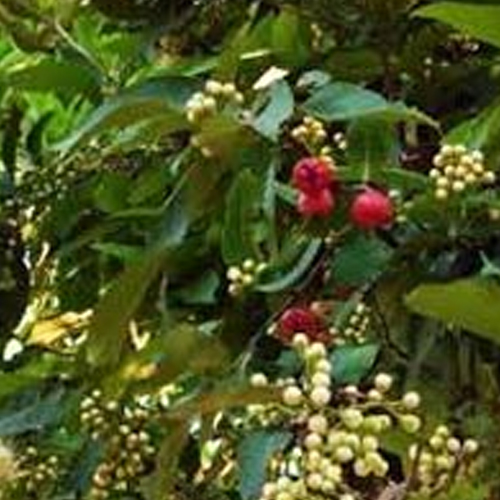
 |
 |
Oud Oil
| Botanical Name | : | Aquillaria agollocha |
| Common Method Of Extraction | : | Hydro-distillation, steam distillation and super critical CO2 extraction |
| Parts Used | : | Oleo resin or wood |
| Note Classification | : | Base |
| Aroma | : | Sweet, complex, deep and woody |
Extraction :
The oil is extracted from the resin of the tree through the process of steam distillation or hydro- distillation
The oil is extracted from the resin of the tree through the process of steam distillation or hydro- distillation
Chemical Composition :
Major compounds in this oil are valencene2 (17.53%), aromadendrene2 (24.76%), + calarene (9.63%), 1(5), 6-Guaiadiene (8.76%).
Major compounds in this oil are valencene2 (17.53%), aromadendrene2 (24.76%), + calarene (9.63%), 1(5), 6-Guaiadiene (8.76%).
Essential Oil Information :
Agarwood or oud is the most expensive wood in the world. The oil is extracted from the resinous heartwood that is found in the trees belonging to Thymelaeceae family. This resin forms as a reaction to fungal or bacterial attack, after which it becomes harder and dark brown to black. Only the infected part is cut for the production of this resinous wood.
Agarwood or oud is the most expensive wood in the world. The oil is extracted from the resinous heartwood that is found in the trees belonging to Thymelaeceae family. This resin forms as a reaction to fungal or bacterial attack, after which it becomes harder and dark brown to black. Only the infected part is cut for the production of this resinous wood.
Oil Properties :
The oud oil is opaque, viscous and dark brown in appearance. The oil exhibits special blending properties due to its thick viscosity.
The oud oil is opaque, viscous and dark brown in appearance. The oil exhibits special blending properties due to its thick viscosity.
Uses :
- In natural perfumery, or meditation or sacred blends
- Used as an aromatic oil in incense
- Effective in the cure of nausea, regurgitation, smallpox, rheumatism, illness during and after childbirth, spasms of the digestive system, cancer, colic, abdominal pain, asthma and epilepsy
Therapeutic Properties :
Aromatic and digestive
Aromatic and digestive
Blends Well With :
Essential oils like myrrh, rose, tuberose, sandalwood, white lotus, pink lotus, frangipani, jasmine, cinnamon bark and pink peppercorn
Essential oils like myrrh, rose, tuberose, sandalwood, white lotus, pink lotus, frangipani, jasmine, cinnamon bark and pink peppercorn
Summary :
Essential oils like myrrh, rose, tuberose, sandalwood, white lotus, pink lotus, frangipani, jasmine, cinnamon bark and pink peppercorn
Essential oils like myrrh, rose, tuberose, sandalwood, white lotus, pink lotus, frangipani, jasmine, cinnamon bark and pink peppercorn
Precautions :
Oud oil is safe and can be worn neat on the skin. However, a patch test is advised before use.
Oud oil is safe and can be worn neat on the skin. However, a patch test is advised before use.
Shipping Options :
The oil is stored in air tight containers and shipped with the support of our partners- TNT, UPS, Fedex, DHL and EMS.
The oil is stored in air tight containers and shipped with the support of our partners- TNT, UPS, Fedex, DHL and EMS.





